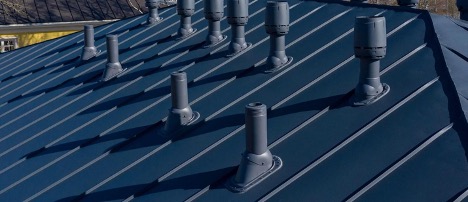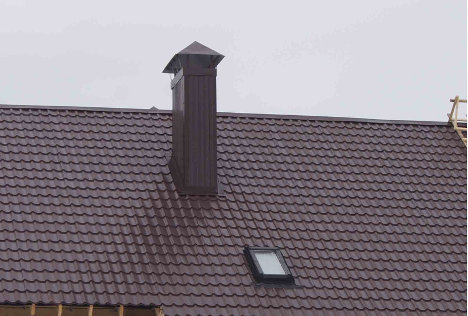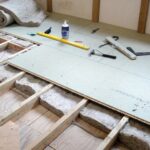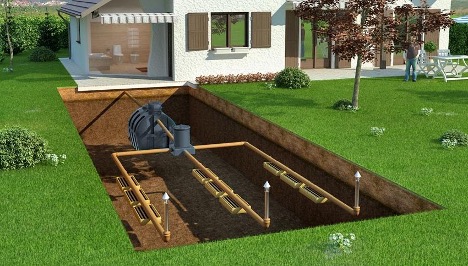The passage of a chimney and sewerage unit through the roof: what it looks like
When it comes to roofing structures, many people wonder what the pipe on the roof of a house is called. This can be either a chimney or a ventilation riser. Both of these elements play a key role in ensuring adequate ventilation. They are also needed for the safety of the living space. Chimneys are necessary to remove combustion products from stoves and fireplaces. While ventilation risers provide the necessary air exchange in the sewerage system.

The content of the article
- Installation of a chimney on a roof ridge: process details
- The passage of a chimney through a roof made of flexible tiles: key points
- System components: sewerage passage through the roof
- Process illustration: chimneys on the roof photo
- Errors when creating a chimney and sewerage passage through the roof
Installation of a chimney on a roof ridge: process details
The location of the chimney on the ridge of the roof not only increases the aesthetic appeal of the building, but also promotes better smoke outflow due to the natural draft created by the wind. This arrangement of the chimney requires special attention to installation details. This allows you to ensure a tight connection with the roof and prevent leaks.
The installation process includes:
- Preparing the hole in the roof taking into account the size of the chimney.
- Installation of a special passage element that ensures tightness.
- Fixation of the chimney and its connection to heating equipment.
The passage of a chimney through a roof made of flexible tiles: key points
Installing a chimney passage through a shingle roof requires a special approach. Flexible tiles are a material characterized by its adaptability and aesthetics. But at the same time, it requires care when performing work on the installation of additional elements. It is important to use special penetration and sealing elements that are specifically designed for flexible tiles. Such elements will not allow the integrity of the roofing to be compromised.
System components: sewerage passage through the roof
The roof sewer passage is an important element of the roofing system, which provides ventilation to the sewer system and prevents the occurrence of vacuum or pressure changes that can lead to malfunction of the plumbing. The installation of such a unit requires strict compliance with building codes to eliminate the possibility of leaks and other problems.
During installation, it is important to pay attention to:
- choosing an installation location that provides effective ventilation;
- use of high-quality sealing materials;
- compliance with the installation technology prescribed by the manufacturer of roofing materials and components for passage elements.
Process illustration: chimneys on the roof photo
Familiarization with chimneys on the roof from a photo can give a clear idea of the various ways of organizing such systems. The photographs help to understand how to correctly position chimneys in relation to other roofing elements, as well as what methods exist for their aesthetic integration into the overall appearance of the building.
Here are a few key aspects to pay attention to:
- The location of the chimney relative to the roof ridge and eaves.
- Examples of using pass-through elements for flexible tiles.
- Options for sealing the sewer passage unit.
These examples illustrate how competent installation and planning can ensure that a roofing system is not only functional, but also visually appealing.

Errors when creating a chimney and sewerage passage through the roof
When creating a passage for a chimney and sewerage system through the roof, various errors may occur, which subsequently lead to leaks, heat loss and other problems in the operation of the building. Errors in these works not only degrade the functionality of the system, but can also entail significant financial costs to eliminate the consequences. Let's look at the most common of them:
- Incorrect selection and installation of pass-through elements. The use of non-compliant passage elements or their incorrect installation may result in water leaks. Each type of roof requires specialized solutions, especially for shingle roofs, where special sealing elements are required to allow the chimney to pass through the roof.
- Ignoring the requirements of thermal insulation and sealing. Insufficient attention to the thermal insulation of the chimney passage element and improper sealing can lead to the formation of condensation, which contributes to the development of corrosion and accelerated wear of structural elements.
- Failure to comply with rules and regulations during installation. Violation of installation technology, including incorrect location of the chimney relative to the roof structures (for example, too close to the ridge of the roof), can cause insufficient draft, as well as leaks.
- Errors when choosing the location of the sewer riser. Installing a roof drain assembly in an inappropriate location where it cannot be properly sloped to effectively drain condensate or where it is subject to excessive mechanical stress (for example, snow accumulation) can lead to blockages and damage.
- Neglecting visual inspection and testing after installation. Failure to thoroughly check for leaks after installing pass-throughs can result in even the smallest defects going undetected until major problems arise.
To prevent these mistakes, it is necessary to carefully plan the work, select quality materials and follow manufacturers' recommendations and building codes. It is also important to involve qualified specialists who have experience in installing roofing systems and can guarantee high quality work.




